SSZT230 november 2020 ISO7021 , ISO7041
To help reduce the risk of such an event, the International Electrotechnical Commission (IEC) has a set of standards within IEC 60079 to protect equipment used in explosive environments. The IEC system for certification of a standard relating to equipment for use in explosive atmospheres is known as IECEx, with the “Ex” label applied to any components or equipment certified and used in such environments.
Although in this article I will mostly focus on IECEx certification, there are also regional versions of the certification, such as Atmosphère Explosible (ATEX) in Europe, that are mostly identical to IEC standards. Part 0 of the international standard (IEC 60079-0, European Norm [EN] 60079-0) covers the general requirements, while Part 11 (IEC 60079-11, EN 60079-11) covers equipment protection by intrinsic safety “i.” Intrinsic safety is a type of protection where restriction of the electrical energy in a system is designed to remain under a level capable of causing an ignition through sparks or heat.
To help meet these requirements, engineers can implement features into their designs such as signal isolation. Signal isolation is an important part of many applications found in explosive environments, such as field transmitters and programmable logic controllers (Figure 1), and is used to improve communication reliability by breaking system ground loops or helping restrict the electrical energy in hazardous environments.
 Figure 1 A programmable logic controller in a factory environment
Figure 1 A programmable logic controller in a factory environmentImplementing IECEx-certified digital isolators in explosive environments
Comparing IECEx-certified digital isolators and optocouplers
Digital isolators like the ISO7041 and ISO7021 that use TI’s capacitive isolation technology, where the high-voltage silicon dioxide capacitors provide a high level of isolation and are constructed in a well-controlled semiconductor process, offer very low device variation. In contrast, optocouplers can have significant manufacturing variability and no TDDB (time-dependent dielectric breakdown) requirement, which is a rigorous and standardized dielectric lifetime assessment.
You can learn more about the device reliability and size advantages of digital isolators in field transmitter designs when compared to optocouplers in the application note, “How to Isolate Two-Wire Loop-Powered Field Transmitters.”
If you’ve been designing with optocouplers and are ready to consider a digital isolator, Table 1 provides the safety or entity parameters and temperature ratings by application scenario for the ISO7041 and ISO7021, based on the ambient temperature range and maximum input power available on each side of the isolation barrier.
| Device | Application (1) | Entity parameters side 1 | Entity parameters side 2 | Ambient temperature | Maximum component temperature |
|---|---|---|---|---|---|
| ISO7041 | IS to IS: case 1 | Ui = 50 V li = 300 mA Pi = 1.3 W Li = 0 H Ci = 4 pF | Ui = 50 V li = 300 mA Pi = 1.3 W Li = 0 H Ci = 4 pF | –55°C to +70°C | 194.3°C |
| ISO7041 | IS to IS: case 2 | Ui = 50 V li = 300 mA Pi = 1.1 W Li = 0 H Ci = 4 pF | Ui = 50 V li = 300 mA Pi = 1.1 W Li = 0 H Ci = 4 pF | –55°C to +85°C | 183.1°C |
| ISO7021 | IS to IS: case 1 | Ui = 50 V li = 300 mA Pi = 1.3 W Li = 0 H Ci = 4 pF | Ui = 50 V li = 300 mA Pi = 1.3 W Li = 0 H Ci = 4 pF | –55°C to +85°C | 183°C |
Since the maximum component temperature of the ISO7041 and ISO7021 in each scenario above is <200°C, these digital isolators are a good fit for equipment rated to temperature classes T3, T2, or T1 within the specified ambient temperature ranges.
Because certified digital isolators enable you to reallocate the power budget for the rest of the system while providing longer lifetimes and increased reliability, they’re an exciting option for complicated and design-limited applications in explosive environments. If you design systems like these and are considering using a digital isolator approach for the first time but have questions, we can help. Post your need or question in our Isolation forum, and one of our engineers will be in touch.